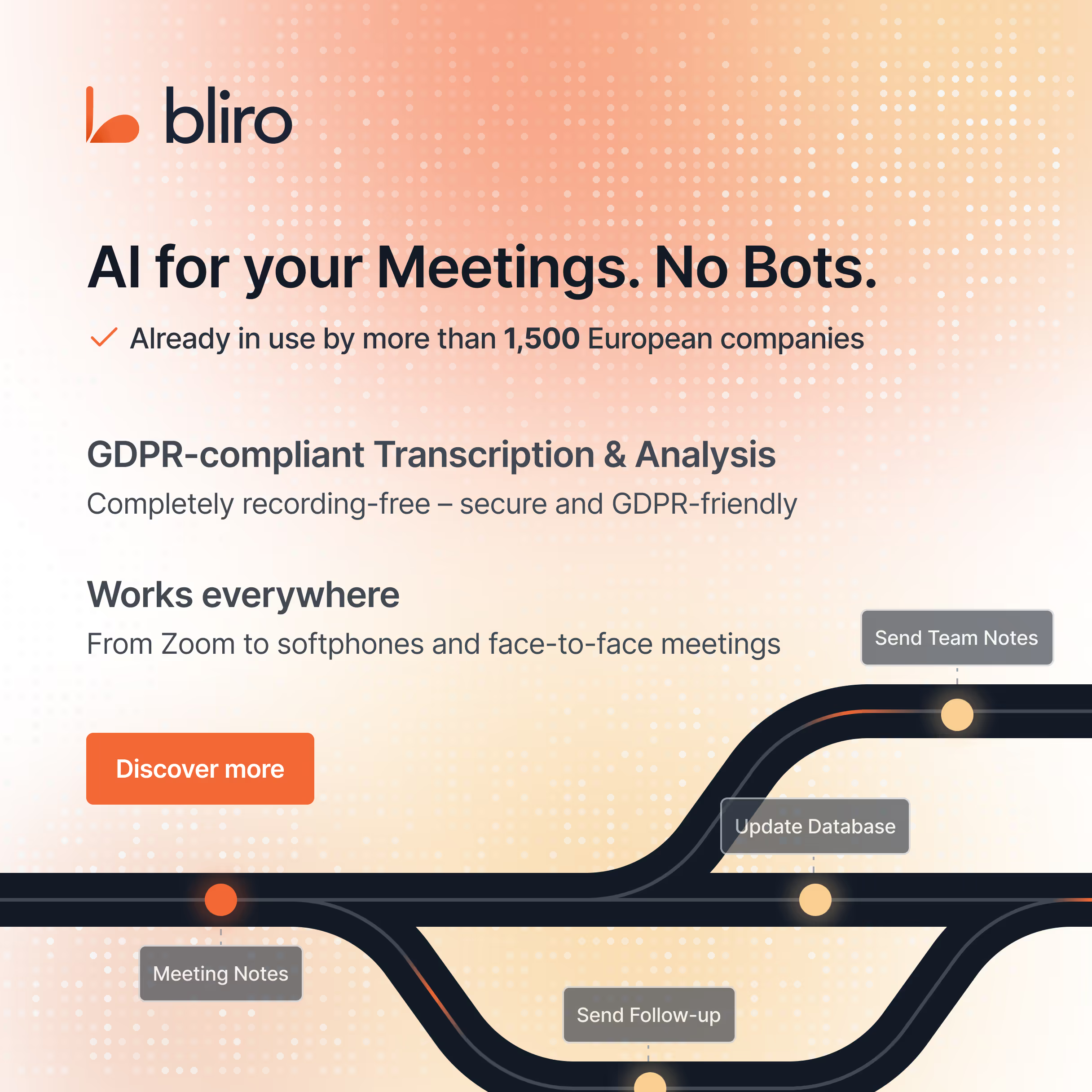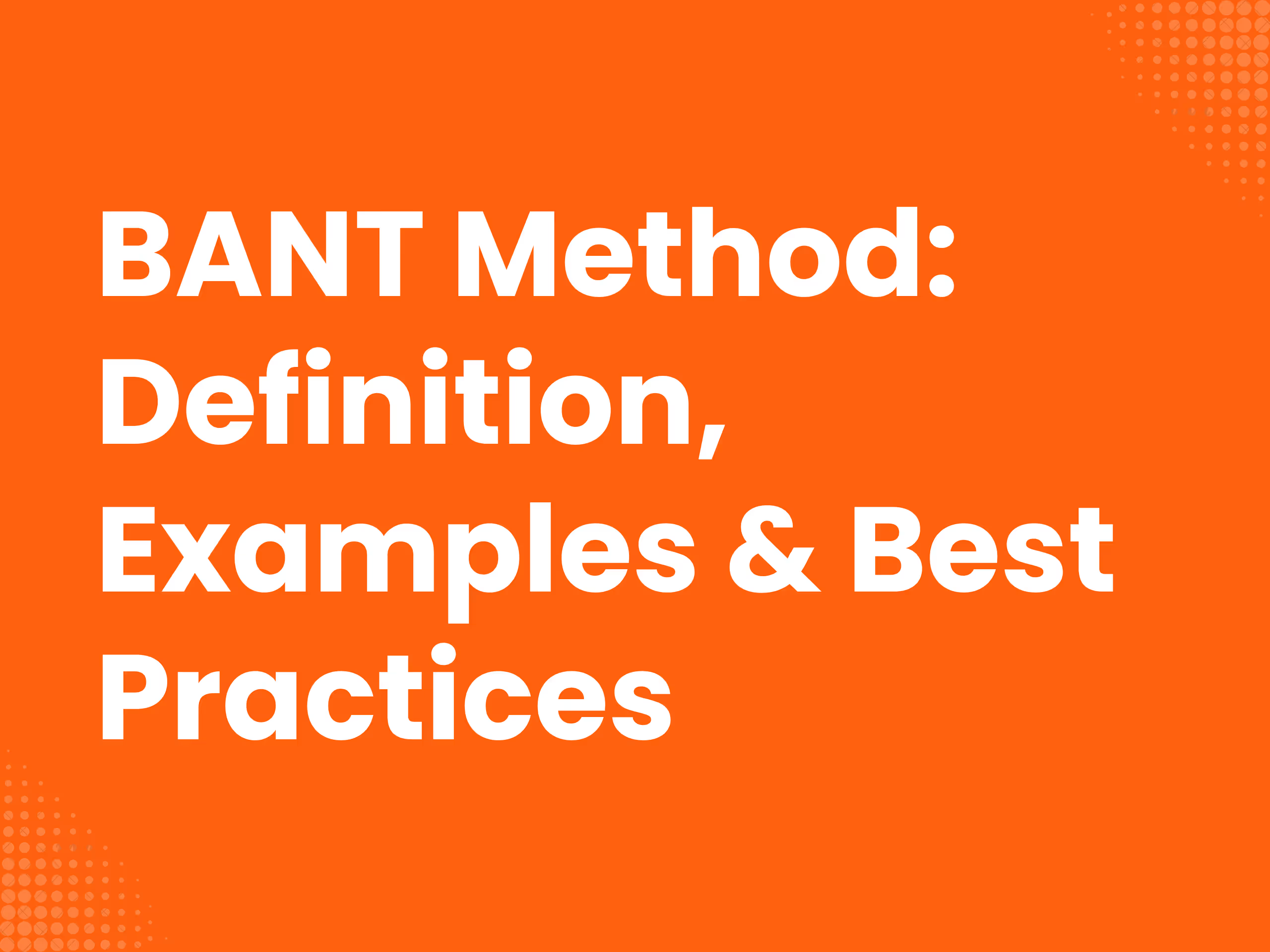BANT is one of the most proven methods of lead qualification in sales. IBM developed this framework back in the 1960s. The acronym stands for four key criteria: budget, authority, need and timing. This systematic evaluation helps you identify promising leads and use sales resources efficiently.
BANT is now regarded as the leading qualification model for prospects at the start of the sales cycle. Sales teams can focus their activities more precisely and focus on prospects with higher closing potential. Especially in B2B sales, this method has established itself as an indispensable tool.
Discover how the BANT method works, how to apply the four criteria correctly, and how modern tools like Bliro can optimize your lead qualification.
What is the BANT method?
The BANT method structures the qualification of leads and potential customers in sales processes systematically. Budget, authority, need, and timing form the four evaluation criteria for sales opportunities. As a result, sales staff quickly recognize which prospects have actual customer potential.
Origins and development by IBM
IBM searched in the 1960s years after effective ways to support its sales teams and developed BANT. The goal: to provide sales staff with a clear framework for better assessment of sales opportunities. Hardware sales to companies shaped IBM's business back then - BANT helped focus limited sales resources on promising leads.
The original concept worked as a systematic checklist for IBM sellers. Direct questions such as “Have you already planned a budget for this?” , “Will you countersign the contract at the end?” or “When should this be done at the latest?” structured sales talks. The approach proved so successful that it was widely used across industries and is still being used today.
Why BANT is so popular in B2B sales
Several factors explain BANT's continued popularity:
Simplicity and ease of use: The method is easy to implement and put into practice. Salespeople understand the components regardless of skills or experience, which enables consistent team implementation.
Efficient qualification: Sales teams quickly determine whether leads have customer potential. Valuable time and resources for unproductive sales calls are lost.
Focus on willingness to buy: BANT identifies potential customers who are currently ready to buy. Salespeople focus efforts on leads that are more likely to close.
Harmonization of sales and marketing: BANT's clear structure improves coordination between sales and marketing teams. Especially with CRM systems benefits arise from implemented qualification criteria.
Difference from other qualification models
BANT is one of the most common B2B sales models, but alternative frameworks serve different sales situations:
- ANUM (Authority, Need, Urgency, Money): Prioritizes decision-making power and emphasizes buying urgency more than time frames.
- MEDDIC (Metrics, Economic Buyer, Decision Criteria, Decision Process, Identify Pain, Champion): Comprehensive model with a focus on economic decision makers, purchasing criteria and pain points. Suitable for more complex sales processes.
- CHAMP (Challenges, Authority, Money, Prioritization): Modified BANT version with focus on challenges and prioritization.
- GPCT (Goals, Plans, Challenges, Timeline): HubSpot's development gives more weight to the goals and plans of potential customers.
Complexity and focus distinguish BANT from newer models. BANT remains simple and seller-focused, while newer frameworks incorporate modern B2B buying processes with multiple stakeholders.
Simple sales situations and short decision-making processes make BANT the ideal choice. More complex sales processes with large buying centers may benefit from more comprehensive models such as MEDDIC.

The 4 BANT criteria: How to systematically qualify leads
The four BANT criteria form the basis of successful lead qualification in B2B sales. Each criterion provides valuable insights into potential customers' willingness to buy and helps you to use sales resources in a targeted manner.
Budget: Does the customer have financial resources?
Budget issues require tact. Direct inquiries for specific figures are often intrusive. A subtle approach with specific questions is more successful:
- “What are your current costs with the existing system?”
- “Our product saves you X a year. How does that relate to your planned budget?”
- “What role do costs play in your decision?”
- “Is there already an approved budget for this project?”
Authority: Who has decision-making power?
Salespeople rarely talk directly to the final decision maker. Identify the Economic Buyer - the person who can say “yes” even when others say “no.” In modern B2B sales, there are usually several stakeholders involved in the buying process.
Effective questions to identify decision makers:
“Who else is involved in decision-making?” “Who can I invite to my next appointment?” “How does the decision-making process work for such projects?”
Bliro collects all this information about various stakeholders and their roles in a structured way so that you can track the decision-making process.
Need: Is there a specific problem?
Real demand is at the heart of every sales opportunity. Without a specific problem, there is no incentive to buy. Determine which pain points your offer actually solves.
Questions about needs assessment:
“What are your most important challenges right now?” “What weaknesses do you see in your internal processes?” “How important is this topic for your business goals?” “What are the effects if you don't solve the problem?”
Rely on open questions - real needs cannot uncover closed questions. Bliro categorizes and prioritizes identified needs for better visibility.
Timing: When is the decision made?
The time frame determines lead priority. Leads with urgent needs and a short-term decision horizon have priority over those with a long-term perspective.
Relevant timing issues:
“By when do you want to achieve your goals?” “Which deadlines must be observed?” “If I calculate back from your target date, we would have to decide by [date X]. Is that realistic?”
Bliro automatically creates Next Steps and To-Do's after every call.
The systematic application of these four BANT criteria enables precise evaluation of sales opportunities and optimal allocation of resources. They create the basis for structured conversations that offer added value to both you and your potential customer.
Using the BANT method successfully: tried and tested interview and CRM integration
A successful BANT application means more than just ticking off a list. It is about targeted conversation that provides valuable insight into real sales opportunities. The right implementation can make your sales process design significantly more efficiently and increase closing rates.
Natural conversation instead of a rigid questioning scheme
BANT works as a structuring guide for sales calls, not as a mechanical checklist. First create a trusting atmosphere before you address sensitive topics such as budget. Get your customer talking and understand their actual needs.
Adapt the BANT criteria individually to each interlocutor. Keep in mind that today's B2B buying processes usually involve multiple stakeholders, while BANT was originally developed for direct 1:1 discussions.
Proven questions for each BANT criterion
These proven questioning techniques help with systematic lead qualification:
Budget:
- “What are your costs with the system that you currently use?”
- “Our product can save X a year. How does that relate to your planned budget?”
- “What role do costs play in your decision?”
Authority:
- “How does the decision-making process for such projects work in your company?”
- “Who else is involved in the decision-making process besides you?”
- “Who can I invite to our next appointment?”
Need:
- “What challenges do you currently see in your internal processes?”
- “What's on your mind the most right now?”
- “What would be the consequences if you didn't address these issues?”
Timing:
- “By when do you want to achieve these goals?”
- “What deadlines do we absolutely have to meet?”
- “If I calculate back from your target date, we would have to decide by [date X]. Is that feasible?”

BANT integration into CRM systems such as Bliro optimizes sales processes
CRM integration makes BANT qualification more systematic and efficient. Create user-defined fields in Bliro for each BANT criterion to record and evaluate collected information in a structured way. This systematic documentation helps sales teams recognize patterns and optimize processes.
Successful CRM integration requires these steps:
- Create custom fields for each BANT element
- Ensure regular data updates by the team
- Use automation rules for lead scoring based on BANT criteria
Consistent recording and updating of BANT information is critical. Customer situation, needs and time frames may change during the sales process. With a solid CRM integration with Bliro Sales reps keep track of things and focus resources on the most promising leads.

4 expert tips for successful BANT use in sales
Maximize the success of your BANT qualification through targeted use. These tried and tested strategies help you exploit the full potential of the method and integrate it seamlessly with CRM systems such as Bliro.
Adapt questions to the lead phase
Adapt the BANT questions to the respective sales phase. Early leads are not yet able to answer detailed budget questions. Start with needs assessment and deepen budget and authority issues later in the process. Bliro allows you to categorize leads accordingly and to store appropriate questionnaires.
Open discussion instead of a list of questions
Don't work through BANT criteria like a rigid checklist. Focus on open questions to identify real sales potential. Instead of direct budget figures, formulate questions that allow conclusions to be drawn. Bliro's call notes feature helps with structured documentation.
Using BANT as a framework for discussion
Use BANT as a starting point for in-depth customer conversations. Don't bomb interested parties with direct questions, but develop a clear picture of the situation through active listening. The flexible Bliro platform directly documents dynamic conversation approaches and important findings.
Building trust before selling pressure
Successful selling goes beyond ticking off criteria. Create trusting conversation environments in which customers talk openly about challenges. Show an understanding of customer needs and gain trust for the entire sales process. Bliro's reminder function helps you plan optimal follow-up times.
BANT alternatives: GPCT, CHAMP & MEDDIC for modern sales processes
BANT remains a proven framework, but modern sales requirements have created new qualification models that better cover specific situations.
GPCT: Focus on goals instead of budget
HubSpot's GPCT method stands for goals, plans, challenges, and timeline. Unlike BANT, this approach focuses less on hard budget issues and more on the customer's strategic goals. Questions such as “What do you expect from the implementation?” or “What challenges are in focus?” create a deeper understanding of customer needs. Bliro documents these findings in a structured way for later analyses.
CHAMP and MEDDIC for complex sales processes
CHAMP (Challenges, Authority, Money, Prioritization) puts challenges first and emphasizes prioritization over timing. This approach works particularly well in consulting-intensive sales. MEDDIC is suitable for complex sales situations with several decision makers and comprises six elements: Metrics, Economic Buyer, Decision Criteria, Decision Process, Identify Pain and Champion. Both frameworks integrate seamlessly with Bliro.
Hybrid approaches for maximum flexibility
Simple sales situations with short decision-making processes continue to work well with BANT. More complex processes or large buying centers, on the other hand, benefit from MEDDIC. You don't have to choose a single framework. A hybrid approach combines various method strengths - such as BANT for initial qualification and GPCT for in-depth discussions. Bliro's customizable fields allow flexible use of different qualification methods.
Conclusion
BANT remains a proven tool for lead qualification in B2B sales. The strength lies in the clear structure: Budget, Authority, Need and Timing help you quickly identify promising leads and use resources in a targeted manner.
Success depends on the right application. Use BANT as a conversation guide instead of as a rigid checklist. Open questions and active listening create trust and provide valuable insights into your prospects' willingness to buy.
The combination with CRM systems such as Bliro maximizes efficiency. Structured documentation, automatic evaluation and flexible adjustment to various frameworks - from BANT to GPCT to MEDDIC - optimize your qualification processes.
Consistent implementation is crucial. Whether you use BANT traditionally or pursue hybrid approaches: With Bliro as a central tool for your sales team, you can increase your closing rates and make optimal use of your sales resources.




